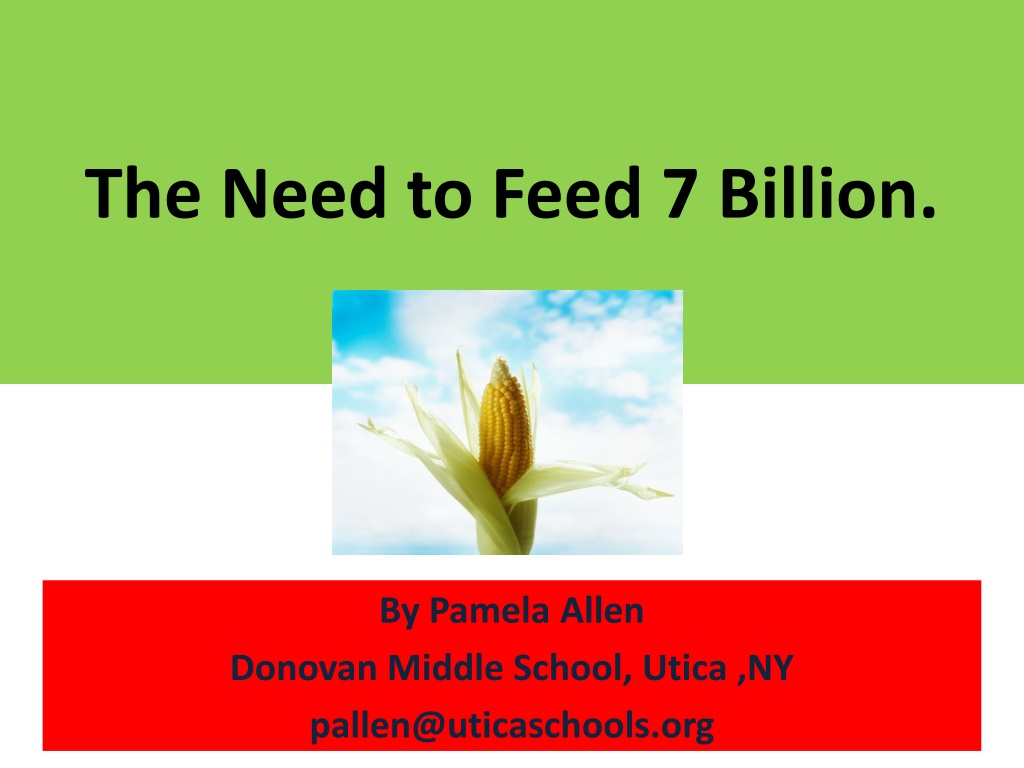
Feeding 7 Billion: A Global Crisis Unfolds
Explore the escalating global crisis of feeding 7 billion people, delving into issues of hunger, dwindling food variety, and looming food shortages due to climate change and limited crop yields. Discover solutions and potential remedies to address this critical problem.
Download Presentation

Please find below an Image/Link to download the presentation.
The content on the website is provided AS IS for your information and personal use only. It may not be sold, licensed, or shared on other websites without obtaining consent from the author. If you encounter any issues during the download, it is possible that the publisher has removed the file from their server.
You are allowed to download the files provided on this website for personal or commercial use, subject to the condition that they are used lawfully. All files are the property of their respective owners.
The content on the website is provided AS IS for your information and personal use only. It may not be sold, licensed, or shared on other websites without obtaining consent from the author.
E N D
Presentation Transcript
The Need to Feed 7 Billion. By Pamela Allen Donovan Middle School, Utica ,NY pallen@uticaschools.org
Todays population situation In 2011, the world s population of humans hit the 7 billion mark. Click on the heading above to get a more exact number for today. C:\Users\pallen\AppData\Local\Microsoft\Windows\Temporary Internet Files\Content.IE5\XJ9G2HCC\MC900078708[1].wmf To see get more information and a visual of what that might look like click here.
What is hunger and why? Take the quiz to help you define hunger. How many hungry people are in the world? According to worldhunger.org, the world produces enough food, but there is not an even distribution of calories, largely due to poverty and conflict. Environmental concerns are affecting food supplies.
Our Dwindling Food Variety As we've come to depend on a handful of commercial varieties of fruits and vegetables, thousands of heirloom varieties have disappeared. It's hard to know exactly how many have been lost over the past century, but a study conducted in 1983 by the Rural Advancement Foundation International gave a clue to the scope of the problem. It compared USDA listings of seed varieties sold by commercial U.S. seed houses in 1903 with those in the U.S. National Seed Storage Laboratory in 1983. The survey, which included 66 crops, found that about 93 percent of the varieties had gone extinct. More up-to-date studies are needed.
A crisis is looming To feed our growing population, we ll need to double food production. Yet crop yields aren t increasing fast enough, and climate change and new diseases threaten the limited varieties we ve come to depend on for food. Luckily we still have the seeds and breeds to ensure our future food supply but we must take steps to save them.
Defining the problem Please define the problem using the attached worksheet.
Food Ark Food Ark 1. Link to and read the article: http://tinyurl.com/foodark 2. What is the authors main point? 3. Pick out three sentences that support his position. 4. What is your opinion of this article? 5. What can be done to remedy the situation? 6. What problems can you predict?
Counting on Uncommon Chickens People eat more eggs and poultry than ever, but the world s reliance on a few high-yielding breeds is edging out hundreds of others: Nearly a third of chicken breeds are at risk of extinction. That s alarming because many varieties have traits, like heat or pathogen resistance, that could be invaluable in the future.
That's a Potato? Unlike the handful of varieties in U.S. markets, potatoes in Peru and Bolivia the species' geographic center of origin come in thousands of colors and shapes. They are so varied in flavor and nutrition that a whole diet can be built around them.
ZEBU Also known as Humped or Brahman, this breed is relied on by farmers in the tropics because it can withstand severe heat. Zebu
RANDALL LINEBACK Sturdy, distinctly marked survivors of a herd indigenous to Vermont, the breed nearly went extinct in the 1980s but is rebounding. Q: Could this breed live in New York?
Sustainable Beef Rare-breed advocates say the best way to preserve vulnerable cattle is to *keep them in the food chain, producing milk or meat. Their motto: "To save them we've got to eat them. *Draw a hypothetical food chain involving cattle .
Seeds Worth Saving Seeds Worth Saving Otherworldly seeds (and their pods) are as varied as the plants they become. Agriculture isn t just about growing food; it includes trees and other plants that produce fiber, control wind erosion, and shade livestock.
credits National Geographic Magazine Food Ark by Charles Siebert, July 2011 Photography by Jim Richardson http://ngm.nationalgeographic.com/2011/07/food-ark/food-variety-graphic National Geographic Magazine The Face of 7 Billion http://ngm.nationalgeographic.com/2011/03/age-of-man/face-interactive http://www.worldhunger.org/articles/Learn/world%20hunger%20facts%202002.htm Today s world population http://www.worldometers.info/world-population/ Slideshow: P. Allen, Utica Schools
